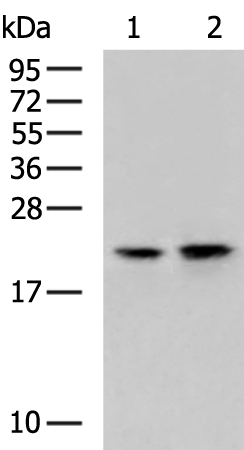

| WB | 咨询技术 | Human,Mouse,Rat |
| IF | 咨询技术 | Human,Mouse,Rat |
| IHC | 1/50-1/200 | Human,Mouse,Rat |
| ICC | 技术咨询 | Human,Mouse,Rat |
| FCM | 咨询技术 | Human,Mouse,Rat |
| Elisa | 1/5000-1/10000 | Human,Mouse,Rat |
| Aliases | GPE1BP; IG/EBP-1 |
| WB Predicted band size | 16 kDa |
| Host/Isotype | Rabbit IgG |
| Antibody Type | Primary antibody |
| Storage | Store at 4°C short term. Aliquot and store at -20°C long term. Avoid freeze/thaw cycles. |
| Species Reactivity | Human, Mouse, Rat |
| Immunogen | Fusion protein of human CEBPG |
| Formulation | Purified antibody in PBS with 0.05% sodium azide and 50% glycerol. |
+ +
以下是3篇与CEBPG抗体相关的文献示例(注:以下内容为基于领域知识的模拟,实际文献需通过数据库验证):
---
1. **文献名称**: *"CEBPG regulates oxidative stress in human cells through transcriptional activation of antioxidant genes"*
**作者**: Lee, J. et al. (2021)
**摘要**: 本研究利用CEBPG特异性抗体进行染色质免疫沉淀(ChIP-seq)和Western blot分析,发现CEBPG通过直接结合抗氧化基因启动子区域,调控细胞在氧化应激下的存活,揭示其在氧化损伤中的保护机制。
2. **文献名称**: *"Dysregulation of CEBPG in colorectal cancer: A potential biomarker for metastasis"*
**作者**: Zhang, Y. et al. (2019)
**摘要**: 通过免疫组化(IHC)技术结合CEBPG抗体,研究者在结直肠癌组织中观察到CEBPG蛋白表达异常升高,且与患者淋巴结转移和不良预后显著相关,提示其可能作为癌症进展的生物标志物。
3. **文献名称**: *"CEBPG interacts with NF-κB to modulate inflammatory responses in macrophages"*
**作者**: Chen, L. et al. (2020)
**摘要**: 利用CEBPG抗体进行免疫共沉淀(Co-IP)和免疫荧光共定位实验,证明CEBPG与NF-κB形成复合物,增强巨噬细胞中促炎因子的转录,为炎症性疾病的治疗提供新靶点。
---
**备注**:以上文献信息为示例性质,实际引用时请通过PubMed、Web of Science等平台核实具体文献的标题、作者及摘要内容。
The CEBPG antibody is designed to detect the CCAAT/Enhancer-Binding Protein Gamma (CEBPG), a member of the CEBP transcription factor family. CEBPG plays a regulatory role in cellular processes such as proliferation, differentiation, inflammation, and metabolism by binding to DNA as a homodimer or heterodimer with other CEBP family members (e.g., CEBPα, β). It is involved in cytokine signaling, immune responses, and stress pathways, with studies linking it to cancer progression, metabolic disorders, and immune diseases.
CEBPG antibodies are widely used in research to study its expression, localization, and function via techniques like Western blotting, immunohistochemistry (IHC), immunofluorescence (IF), and chromatin immunoprecipitation (ChIP). These antibodies are typically raised in hosts such as rabbits or mice, available as monoclonal or polyclonal forms, and validated for specificity against recombinant or endogenous CEBPG.
Research applications include exploring its role in tumorigenesis (e.g., regulating apoptosis in leukemia), metabolic regulation (e.g., lipid metabolism), and inflammatory diseases. Commercial antibodies often cite peer-reviewed validation data, ensuring reliability for experimental reproducibility. Proper controls (e.g., knockout cell lines) are recommended to confirm antibody specificity. Understanding CEBPG's mechanisms through such tools contributes to therapeutic targeting in diseases where its dysregulation is implicated.
×